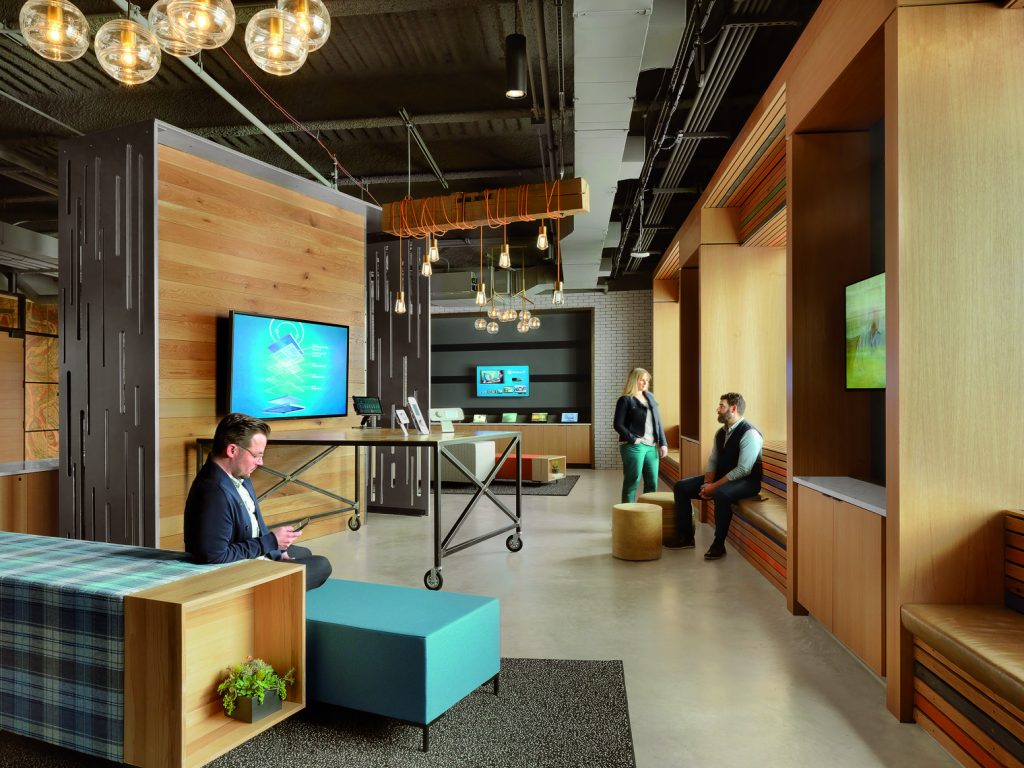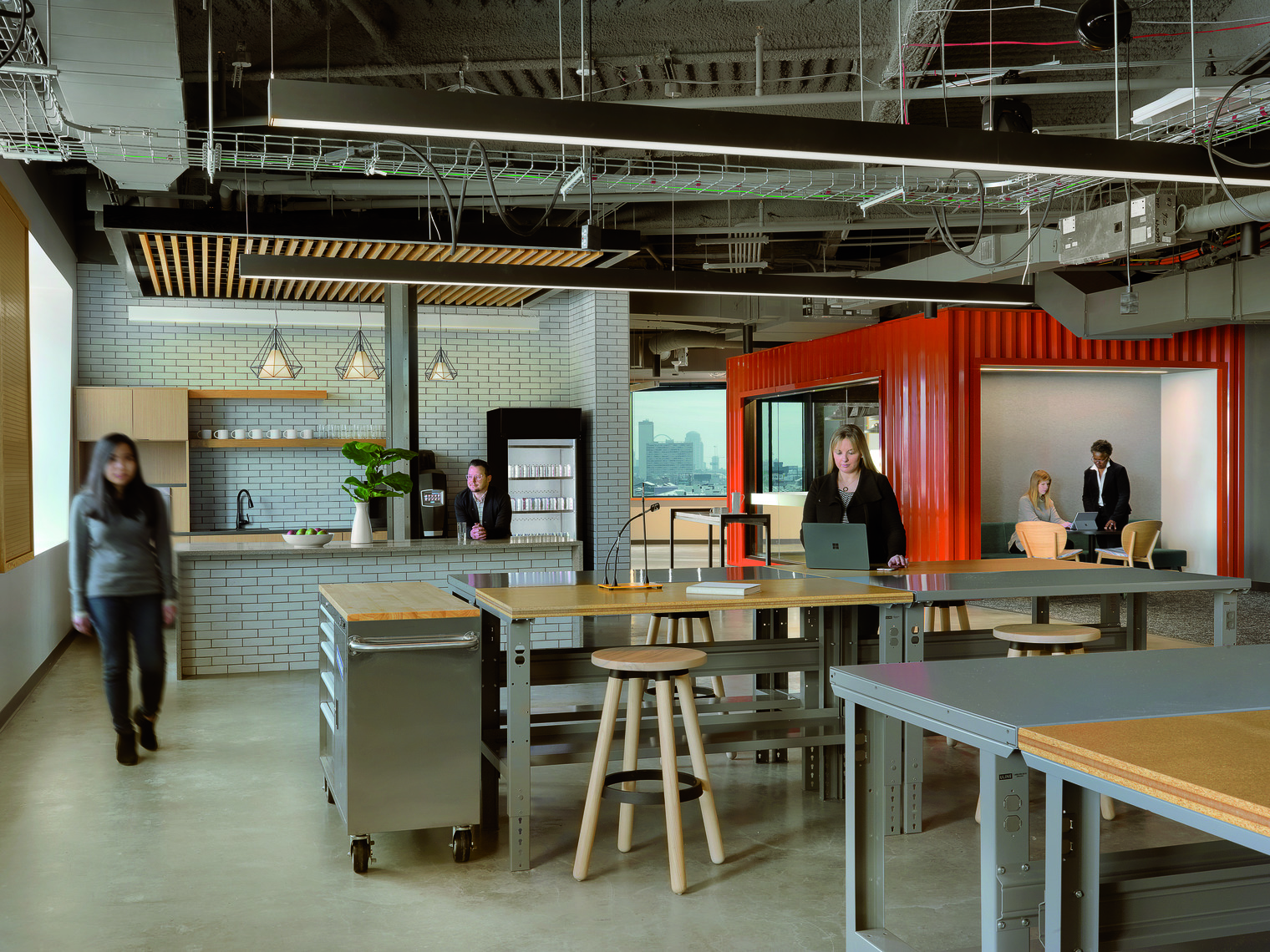by Kay Sargent — This article originally appeared in the July/August 2019 issue of FMJ
We are living in a time in which exponential change is driven by advances in technology, automation, the emergence of the sharing economy and the fall of siloed space, all of which is having profound impact on the spaces and places that we create. Regardless of the abundance of innovation, many of us are still working in spaces where technology is frustrating at best.
With all this access to technology 24/7, the inability to disconnect in a seemingly ever-connected world is causing dramatic increases in stress levels among workers today. The World Health Organization (WHO) projects techno-stress – the stress of constantly being on and overwhelmed by technology – will be one of the biggest health issues in the coming decade. Although we are more connected than ever, loneliness and poor social connections are on the rise. For many people, work is not working.
Facing the challenge
As the world welcomes new tech advances, we are seeing new opportunities to embrace new ways of work emerging.
The ability to merge the digital and physical worlds creates an opportunity to enhance the user experience. By creating an immersive and interactive realm that seamlessly interweaves the physical and virtual worlds, people have more options at hand and more ready access to information. The objects that reside in the real-world are “augmented” by computer-generated perceptual information and are often multiple sensory modalities, including not only visuals, but also smell and sounds.
The real value of the IoT is not tracking users, but leveraging sensors to create better user-experiences, hence creating the IoE, Internet of Experiences, and enabling WorkHOW. Be it identifying a space that meets your preferred lighting, temperature or noise levels or adjusting the space to your specific settings – people can determine when, where and how they want to work. We need to be aware that data collected from a singular point is thin at best and can led to false conclusions. Thick data, on the other hand, is the compilation of data taken from multiple viewpoints, queried by human understanding with logic applied and addresses the whys.
Times are a-changing
The emergence of the gig, or freelance, workforce has opened nontraditional hiring options. Forty-four percent of the workforce is temporary help, staffing agency help, part-timers, contractors, freelancers and gig workers. However, by 2025 more than 50 percent of the global workforce will be gig workers. This provides opportunities for companies to rethink their hiring practices and create pools of just-in-time workers to supplement a core group, thus ensuring companies do not have too many or too few employees.
Recent reports have outlined the threat of climate change and noted that a government-led mass mobilization effort can potentially transform society quickly enough to avoid global catastrophe. The proposed Green New Deal initiative would entail greening the energy grid; encouraging a shift to electric vehicles and mass transit; the densification of existing cities and building new ones from scratch while retrofitting the existing building stock. The impacts on corporate real estate and the design and construction industries would be profound.
Establishing a disconnect
Given the challenges and opportunities at hand, there are some key steps we can take and concepts we can embrace to ensure we are optimizing work environments, improving efficiencies and effectiveness, and creating great experiences.
The inability to disconnect is causing a dramatic increase in stress levels among workers today, with 70 percent reporting they feel overwhelmed daily. We need to design spaces that help people function at higher levels and feel refreshed so they are truly effective.
CONSIDER creating quiet zones, tech-free days or blocking emails from passing through your servers during certain off-hours. Also consider creating zones within the workspace where people can work “alone together” or designated spaces for more solo concentrative work, be it individual work points on the perimeter and away from team areas or focus rooms.
As we shift away from focusing on incremental productivity, where it is about producing things faster, better and cheaper, a new model is emerging. Divergent creativity leverages different expertise and points of view to co-create and drive to more game-changing innovation that break through boundaries. The sage on the stage empowered by PowerPoint is replaced with the democratization of meeting where everyone can contribute, leading to inclusive ideation and speed to innovation.
CONSIDER creating scrum areas for ideation and work project spaces, or dojos, for extended assignments that have both digital and analog information sharing opportunities.
Predictions / Recommendations
- As robotics do more production, measuring that will not matter as much. Companies will live and die by their ability to innovate and adapt.
- Everyone is crazy for data, constantly wanting more. But the data we have is not convincing people of much. We need to trust common sense and our intuition and get better, thicker data.
- We need to proceed with caution. Once new technology is out of the bottle, we cannot put it back in. Facial recognition, robotics, etc. – there is a dark side to it all.
- Sensors that monitor and track us are not popular. When we can leverage the information gathered to empower us, people will get on board.
- Yes, robots and AI will replace some jobs. But new ones will be created. Are your people prepared to shift into those newly created positions?
- Yes, user experience is important, but user expectations should be the focus.
- A lot of change is coming in the next decade and will impact the environments we are building now. We need to design to be future-ready. You cannot future-proof. Developing plausible scenarios and remaining agile is key.
- We need to incorporate aspects of higher-education to enable life-long learning and reskilling of the workforce; design for divergent co-creation; and leverage community sharing of amenities going forward.
A sense of belonging
Much focus has been on the younger generation, but the worker is aging, so space today needs to be designed to be inclusive for all generations, genders, personality traits and ethnicities. Space today needs to reflect the diverse makeup of organizations as we are becoming a majority of minorities. We are also living in a time of increased numbers and awareness about neurodiverse individuals who may be ADHD, on the autistic spectrum, dyslexic or have early signs of Parkinson’s disease. These individuals can be high energy, risk-takers, good in a crisis and bold problem solvers, but most work environments today are not designed to support them.
CONSIDER designing spaces that are an ecosystem of work settings that can help accommodate and be inclusive for all.
People today are becoming untethered to their desk and can work anytime, anywhere. So we need space that supports that freedom of movement and is designed to operate without direct human control. Smart-tech can help create a truly intelligent, autonomous workplace designed to support users.
CONSIDER utilizing technology to aid in making the environment adjust to us, instead of us having to adjust to it. Biometrics, smart fobs and sensors can help identify our preferences and provide preset solutions that adjust to us and provide access to data and information when and where we need it.
Exceptional amenities will continue to be a differentiator and create destination locations. Providing a wide variety of gathering spaces and food and beverage options is important for building community and meeting people’s physical and social needs. High-quality coffee is a valued perk.
CONSIDER going beyond owned and controlled amenities and leverage the power of the sharing economy. Access to amenities replaces the need for each and all to have separate dedicated amenities. Savvy companies are leveraging the amenities within the facilities and neighboring buildings not only to reduce cost, but to create a more vibrant, connected community with more options for their workforce.
Be flexible
People want options and choices when it comes to how they work. Sitting stagnantly is not only bad for our health and well-being, it is bad for productivity. When people have no options, they can be stuck sitting next to somebody they may not mesh well with, which can adversely impact their engagement and overall performance.
CONSIDER designing spaces that encourage movement and give people a variety of options. Activity-based environments allow people to choose the right setting for the task at hand. The environment also enables them to find the right community of co-workers so they feel more supported and connected. When people bond, they open up and become more trusting. That is when real innovation happens.
Today’s workplace features a generation who is not just working to feed their families, they are working because they want to make a difference. They want their companies to have a clear mission and they want to believe in that mission. People want and need to feel connected to the purpose of the business. It is vital for employees to get excited and motivated about the company’s work.
CONSIDER designing spaces to connect people to the core of what the company does and why they do it. Spaces that are designed to infuse transparency and openness help employees tap into that sense of purpose and meaning while fueling their desire to perform. Space should be the physical embodiment of a company’s mission, values and culture.
High EQ
Machines may excel at computational capabilities and be the “Science of the Job,” but humans excel at the “Art of the Job.” Soft skills — our ability to connect, empathize, motivate and inspire, and our EQ/emotional intelligence — how we relate to others, apply insight and judgment is what separates us from machines. Leadership skills and the ability to apply emotion and ethics in social context has a renewed importance today.
CONSIDER designing space that embraces the concept of “high-tech equals high-touch.” Simply put, most of us feel overwhelmed by technology today, so designing spaces that are “high-touch” and bring organic, natural elements into the interior environment while making things more transparent, genuine and real is a welcome check to “high-tech.”
We need to move away from people working in isolation. When employees are interconnected and can see the work each is doing, their role takes on more significance and purpose. They feel more excited and connected to the business.
CONSIDER spaces that break down silos and provide areas for meaningful exchanges. Wider passageways, social areas, interconnecting stairs and atriums, and common amenities— not only within the building, but among the neighboring facilities as well— can create an enhanced sense of connection and provide opportunities for discovery, collaboration and community.
Empowering people through design
What is truly driving the need for change? The desire to better enable people to live and work in optimum conditions. Hence, we are seeing the parallel rise of the machine age and the rise of the human factor. These two streams are already converging in the workplace and changing not only the tools we use, but when, where and how we work as well. The ability to combine space and technology solutions to democratize space and enable divergent creativity is at hand. To truly be inclusive we need to design spaces that accommodate and empower a diverse workforce, not one single group, generation or worker type. Workspaces must integrate smart-tech solutions that enable people to thrive and be successful. We are no longer in the business of designing work spaces, but creating holistic workplace experiences that have a tremendous impact on people’s well-being – not just their physical, but social, emotional and financial well-being. Change affords us an opportunity to recalibrate and create destination work environments where people can thrive and, as a result, organizations can prosper.
 About the author
About the author
Kay Sargent, ASID, IIDA, CID, LEED® AP, MCR.w, WELL AP is a senior principal and director of WorkPlace at HOK.


